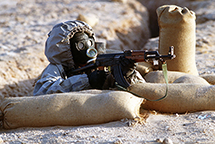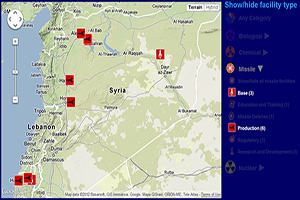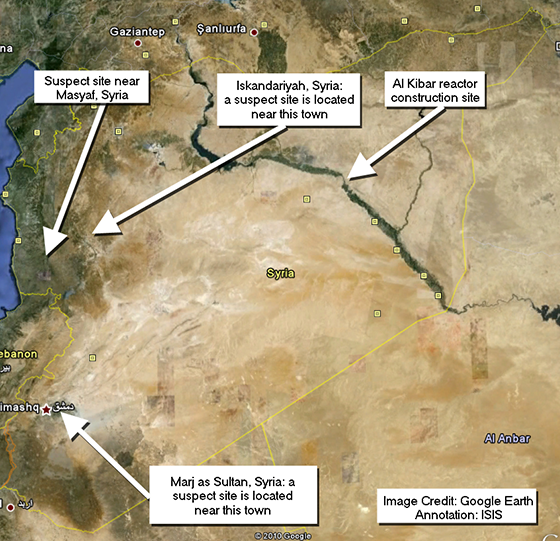
Syria Military, Department of Defense
Leonard S. Spector
July 19, 2012
Minimizing Dangers Posed by Syria’s Military Assets During and After The Current Civil Turmoil
Testimony of Leonard S. Spector (1) before the Subcommittee on Terrorism, Nonproliferation, and Trade, Committee on Foreign Affairs, US House of Representatives, July 19, 2012.
Chairman Royce and Ranking Minority Member Sherman, thank you for the opportunity to appear before the Subcommittee.
Minimizing the dangers posed by Syria’s military assets is a challenge of considerable complexity. In thinking about this threat, we must start by appreciating a number of parameters.
Classes of Military Assets
First, we need to differentiate among at least five classes of assets:
- Small arms and light weapons
(e.g., automatic rifles, light machine guns, mortars, and rocket propelled grenades) - Heavy weapons
(e.g., tanks, artillery, aircraft) - Weapons of particular danger if acquired by terrorists
(MANPADS, high explosives, land mines, unguided rockets) - Ballistic missiles, and
- Chemical weapons
(Biological weapons may also be at issue, but little is known about Syria’s possible program. Nuclear weapons and fissile material are not known to be present in Syria. Certain sites, however, are suspected of having equipment or facilities that could be relevant to their production.)
As I will discuss in a moment, each of these categories of weapons may require a distinctive approach.
US Goals Outside Syria and within the Country
US goals are a second parameter to bear in mind as we think about the future of Syria’s military assets. What dangers, specifically, that arise from Syria’s military holdings do we hope to minimize?
Outside Syria, I believe our core objective is to ensure that Syria’s various assets do not find their way to parties, such as Hezbollah, anti-government insurgents in Iraq, the Taliban, or al-Qaeda; in any of these cases, the added military capabilities could create immediate new dangers for the United States or our allies. We also want to take steps to keep these assets from being used in local conflicts outside Syria, such as those in Africa, even when we are not directly involved, a problem that developed in Chad, after Gaddafi’s regime in Libya collapsed.
Within Syria, our goals are very diverse. It is not clear, for example, that during the current turmoil, we would like to see all classes of weapons remain under the control of the Assad regime. Presumably, we would be pleased to see the Free Syrian Army capture stocks of Assad’s small arms and light weapons; indeed we are currently facilitating the provision of weapons in this category to these fighters. I assume we would also be pleased to see defections by large, heavily armed units of the Syrian military to the side of the insurgents, as well as defections of units responsible for Syria’s arsenal of several hundred SCUD and other guided missiles. Such defections would erode Assad’s claim to leadership and, in the case of heavy weapons, deprive him of at least some of the capabilities he has turned so viciously and indiscriminately against civilians.
Where easily portable weapons of particular interest to terrorists, are concerned, however, continued positive control by government forces is probably safest, since terrorist groups are known to be operating in the country in parallel with the Free Syrian Army. While the latter can probably maintain positive control over pieces of large, high-value equipment it acquires, such as howitzers, aircraft, and guided missiles, the Free Syrian Army might have greater difficulty maintaining effective custody of hundreds of easily pilfered and concealed items, like MANPADS and land mines.
As for Syria’s chemical weapons here our most urgent goal is to ensure, for humanitarian reasons, that these weapons are not used in the current conflict. As the Obama Administration reiterated yesterday, Assad has been warned not to take this step, which would certainly lead to calls for military intervention against him that even Moscow would find hard to oppose.
Our second goal with respect to Syria’s chemical weapons, of course, is to ensure that positive control over these weapons is maintained and that chemical agent and munitions are not transferred to others. Readily transported chemically-armed artillery shells would be the easiest to divert and could be used by Hezbollah or another group possessing standard artillery pieces of the type found in Syria’s armory. Even limited numbers of chemical munitions transferred to Hezbollah could notably worsen the threat to Israel and reinforce deterrence against future Israeli retaliation for conventional rocket and missile attacks. As noted, Al Qaeda also operates in Syria. Terrorist detonation of even a handful of chemical munitions in a Western city could wreak havoc. Adding to concerns, the loss of control over the vast Syrian chemical arsenal could make it impossible to establish that none of it had passed into new hands.
The United States and its allies in the region are developing plans to address such contingencies, in particular, preventing the large-scale transfer of chemical arms out of Syria. Indeed the recent Eager Lion 12 exercise in Jordan, involving 19 nations and more than 12,000 participants, is said to have included this scenario among others.
Time and Geography
Timing is another key parameter to bear in mind as we develop strategies to reduce the risks from Syria’s arsenals. Broadly speaking, we need to think in terms of three time frames: the current period of increasingly violent hostilities; the period of transition to a post-Assad government of one type or another; and the period after the authority of that government has been established within Syria. As I will discuss in a moment, certain opportunities to reduce risks may arise in the two earlier phases that may dissipate once a new government takes control.
Geography is closely linked to timing. By this I mean that if current trends continue, increasing portions of Syria will come under the control of insurgent forces, as the period of transition nears. Already some reports are suggesting that Assad is focusing on maintaining control the country’s major cities, while the Free Syrian forces are increasingly taking over in the countryside.
It is my understanding that CW storage facilities were deliberately built outside major population centers, probably to enhance secrecy and as a safety precaution. Production facilities are likely outside city centers. Thus it is possible that as the current phase of the conflict unfolds, such facilities may fall within insurgent-controlled territory. Although it has been reported that Syria has recently moved some of its chemical weapons, possibly to more secure locations, some chemical assets, such as large stocks of bulk agent may be difficult to relocate and may remain in situ and at risk of diversion. (Airfields, missile storage and production sites, and other fixed military assets could also fall behind the insurgents’ lines.)
Under a number of scenarios, the expansion of insurgent controlled territory could lead to loss of control over portions of Syria’s chemical arsenal by the elite troops entrusted to secure these assets. For example:
- Custodians could be pulled out of such locations and reassigned to the front lines of the unfolding civil war, much as Assad recently pulled troops from the Golan Heights area to protect Damascus.
- Custodians could desert their posts to return to and protect their families as domestic turmoil continues.
- Depending on the ebb and flow of battle, Assad could abandon chemical weapon sites and their custodians if it were not possible to maintain lines of supply and communication with them.
- Custodians could defect to the rebel cause, transferring control over chemical weapon stocks to the Free Syrian Army, which is noted for its confused lines of authority and whose plans to manage such materials are likely non-existent.
- Custodians, weakened by isolation, could be overrun by insurgent troops, if the Free Syria Army leaders sought to demonstrate, through capture of a site symbolizing Assad’s military strength, that the Syrian leader was losing his grip on power.
- Or, the in unfolding chaos, bribery, bargaining for passage out of the country, or ideological commitment could lead guardians to offer up assets under their control to Hezbollah, al-Qaeda, or other non-state actors.
One measure that should be implemented immediately is to make clear that chemical weapon custodians who find themselves behind insurgent lines and who peacefully relinquish formal control over these stockpiles and then stay in place to protect them from misadventure, will be protected, and even rewarded, by the post-Assad government.
We must also look ahead to the aftermath of the current conflict and think about what assets the post-Assad government will inherit and how these will be managed.
The transition period is likely to be particularly chaotic. Small arms and light weapons, for which there is a ready and lucrative international market, will likely be extensively pilfered. Given the scale of Syria’s arsenal and the likely dispersion of its armories, this may be all but impossible to prevent. Heavy weapons (including aircraft), missiles, MANPADS, bulk explosives and land mines may be stored in fewer locations, more rigorously inventoried, and thus more easily controlled. Planning for international support to assist in this control mission is needed now, with due consideration to including Russian participation to avoid the appearance of Western intervention.
There are several weapon types that we would not want to see in the arsenal of the next Syrian government, however: Assad’s existing chemical weapon production capabilities and stocks; his inventory of 300- and 500-kilometer-range Scud missiles and shorter range, but more accurate SS-21 missiles; and such remnants of his apparent nuclear weapon program as may exist. We should take steps now and during the fluid transition period to shape the future of these systems.
Syria’s chemical weapons fall into a special category — the only weapons currently in Syria’s possession considered innately abhorrent by the international community. Syria is one of a handful of states that have not joined the 1997 Chemical Weapon Convention, which prohibits parties from possessing these weapons and requires parties to destroy existing stocks. A key goal for the United States, which would be widely supported by other nations, would be to orchestrate Syria’s commitment to eliminating its chemical arsenal and joining the Convention.
Washington and its friends in Europe and in the region will have powerful inducements. For governments coming to power through revolution, civil war, or secession, gaining international recognition and legitimacy are crucial, immediate goals, as are integration into the world economy and, depending on the circumstances, obtaining significant outside economic assistance. Renouncing weapons of mass destruction by terminating suspect activities, eliminating stocks, and subscribing to key nonproliferation treaties has repeatedly been made a requirement for such benefits. Argentina, Brazil, South Africa, Belarus, Kazakhstan and Ukraine all took these steps, focused on renunciations of nuclear weapons or nuclear-weapon programs, in the 1980s and 1990s.
Libya did so, as well, in 2003, following a sudden volte-face decision to seek accommodation with the international community following decades of rogue behavior. Indeed, Libya abandoned its nuclear weapon program and also joined the Chemical Weapon Convention, agreeing to destroy its sizeable chemical arsenal after placing it under the monitoring system of the Organization for the Prohibition of Chemical Weapons (OPCW). By the time the Libyan civil war erupted in February 2011, it had destroyed more than half of its stocks of chemical warfare agent. The new government in Tripoli has pledged to continue this process.
The Syrian government that replaces Assad must be pressed to take similar steps as a condition for recognition and sustained support. Unfortunately, unlike Libya and the other previous renouncing states, which faced no external antagonists when they abandoned their WMD, any government that takes power in Damascus can be expected to consider itself the heir to Syria’s decades-long confrontation with Israel. In these circumstances, Syria’s chemical arsenal may be seen both as an essential deterrent to counter Israel’s nuclear capability and as a valuable bargaining chip, to be relinquished only in return for a significant concession from Israel, such as return of the Golan Heights.
To avoid such a relapse to the status quo, as the Free Syrian Army seizes territory where chemical facilities are situated (see map attached to this testimony) in coming weeks and, thereafter, as the Assad regime approaches collapse, with neither the regime nor the insurgents fully controlling the state apparatus, Washington and its allies must take steps to negotiate international monitoring and security arrangements for these sites. It may be best for us to do this with another country taking the lead, such as Turkey, the Netherlands (home of the OPCW), or Sweden. Access to sites would be negotiated with the Free Syrian Army for facilities within territory it controlled and, clandestinely, with site managers for facilities nominally remaining within Assad’s chain of command. If successfully executed, conditions on the ground will establish the presumption that the arsenal must be eliminated before a new government can revert to Syria’s traditional stance.
Because the moment will pass quickly, the United States must begin planning now to seize this opportunity. Otherwise, Syria’s chemical armaments could continue to cast their shadow over the region for decades to come.
Scuds and SS-21 Missile Legacy
The United States and other Western states should also use the leverage of recognition and assistance to demand the elimination of Syria’s WMD-capable missiles and associated production facilities. Washington followed this approach in gaining the elimination of Scud and more powerful missiles in Eastern Europe after the fall of the Soviet Union, and Gaddafi also accepted destruction of his Scuds as part of his accommodation with the international community.
It is also possible that these systems will become targets for the Free Syrian Army or other insurgent elements now operating in Syria. Destruction of such potent symbols of Assad’s power would deal his regime a grievous political blow. In addition, these systems and production capabilities could prove to be attractive targets for commando operations by a number of states in the region. Unlike attacks on chemical sites, attacks on missile sites would risk only limited off-site damage.
Nuclear Legacy
Here, the United States should also use its leverage and take advantage of shifts in territorial control and the flux of the transition period to resolve outstanding questions regarding Syria’s apparent nuclear weapon program, whose centerpiece, a nearly operational North Korean-built reactor near al-Kibar, was destroyed by Israel in September 2007. Although Syria is a party to the nuclear Nonproliferation Treaty (NPT) and is obligated to place all of its nuclear facilities under monitoring by the International Atomic Energy Agency (IAEA), the Assad government has refused to permit international inspectors to visit three sites suspected of being part of the Syrian nuclear program. (2) If the sites come under insurgent control, the Free Syrian Army should be pressed to authorize such inspections, perhaps starting with an informal visit by a team of international experts to these locations (akin to visits of this kind to Libyan WMD sites in 2003) to begin resolving these issues concerning their nature and purpose.
Resources and US Programs
In the past, funds from the State Department’s Nonproliferation and Disarmament fund have been used to support extraordinary engagements of this kind aimed at reducing risks from weapons of mass destruction (WMD) and related high-end terrorism threats. Preparing now for use of such funds in the case of Syria is most desirable, starting with any necessary authorizations in appropriate legislation. Considerably greater funds would also be available through Department of Defense Cooperative Threat Reduction Program, once it is certified to operate in the Middle East. Obtaining this certification, which I believe is now in process, should be an urgent priority.
Notes
(1) The views expressed are those of the witness. The James Martin Center for Nonproliferation Studies does not take institutional positions on matters of public policy.
(2) According to press reports, the sites are located near Masyaf, the village of Marj as-Sultan near Damascus, and Iskandariyah. See, David Albright and Paul Brannan, “Satellite Image Shows Syrian Site Functionally Related to Al Kibar Reactor,” Institute for Science and International Security, December 1, 2010. A map from this analysis is attached at the end of this testimony.


